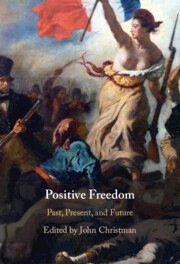Book contents
- Positive Freedom
- Positive Freedom
- Copyright page
- Contents
- Contributors
- Acknowledgments
- Introduction The Multiple Dimensions of Positive Freedom
- Chapter 1 Unity and Disunity in the Positive Tradition
- Chapter 2 Positive Liberty as Realizing the Essence of Man
- Chapter 3 Moral and Personal Positive Freedom
- Chapter 4 Positive Freedom and Freedom of Contract
- Chapter 5 Recognition and Positive Freedom
- Chapter 6 Self-Mastery and the Quality of a Life
- Chapter 7 Basic Freedom in the Real World
- Chapter 8 Reframing Democracy with Positive Freedom
- Chapter 9 Disability and Positive Liberty
- Chapter 10 Positive Freedom and Paternalism
- Chapter 11 Beyond Positive and Negative Liberty
- Chapter 12 Property and Political Power
- Chapter 13 Public Reason, Positive Liberty, and Legitimacy
- Works Cited
- Index
Chapter 3 - Moral and Personal Positive Freedom
Published online by Cambridge University Press: 03 September 2021
- Positive Freedom
- Positive Freedom
- Copyright page
- Contents
- Contributors
- Acknowledgments
- Introduction The Multiple Dimensions of Positive Freedom
- Chapter 1 Unity and Disunity in the Positive Tradition
- Chapter 2 Positive Liberty as Realizing the Essence of Man
- Chapter 3 Moral and Personal Positive Freedom
- Chapter 4 Positive Freedom and Freedom of Contract
- Chapter 5 Recognition and Positive Freedom
- Chapter 6 Self-Mastery and the Quality of a Life
- Chapter 7 Basic Freedom in the Real World
- Chapter 8 Reframing Democracy with Positive Freedom
- Chapter 9 Disability and Positive Liberty
- Chapter 10 Positive Freedom and Paternalism
- Chapter 11 Beyond Positive and Negative Liberty
- Chapter 12 Property and Political Power
- Chapter 13 Public Reason, Positive Liberty, and Legitimacy
- Works Cited
- Index
Summary
An increasing appreciation of the moral dynamic of freedom has led to the development of a range of positive conceptions of liberty. For T. H.Green positive freedom concerns the acquisition of moral agency, and this acquisition is made possible through successful internalisation of moral ideals. Interestingly, however, moral ideals have been seen both as constitutive of – as in the case of Green – and as threatening to positive freedom. Christman defines positive freedom as a form of autonomy, key aspects of which are one’s capacity to be “moved by values, desires, and motives that are reflections of an authentic, reflective self and not entirely alien to the agent or externally imposed by manipulative forces outside his control.” In other words, for Green positive freedom depends on the internalization of existing moral ideals, even though this has to be critically done, while for Christman it depends on our effective capacity to question such ideals. In this paper, I argue that positive freedom cannot both aspire towards values but also effectively resist them. We need to choose whether to align positive freedom with the first or the second. I argue that positive freedom should be understood as the acquisition of moral agency or attainment of excellence in a recognized field and that both of these entail some form of value affirmation.
- Type
- Chapter
- Information
- Positive FreedomPast, Present, and Future, pp. 45 - 64Publisher: Cambridge University PressPrint publication year: 2021
- 1
- Cited by

